NSC COP87L42RJN-3N, COP87L42RJN-1N, COP87L42RJM-3N, COP87L42CJN-2N, COP87L42CJN-1N Datasheet
...
PRELIMINARY
September 1999
COP87LxxCJ/RJ Family
8-Bit CMOS OTP Microcontrollers with 4k or 32k Memory
and Comparator
General Description
The COP87LxxCJ/RJ Family OTP (One Time Programmable) microcontrollers are integrated COP8™ Base core devices with 4k or 32k memory, and an Analog comparator (no brownout). These multi-chip CMOS devices are suited for lower-functionality applications, and as pre-production devices for a ROM design. Low cost, pin and software compatible (plus Brownout) 1k or 2k ROM versions are available (COP820CJ/840CJ Family). Versions are available for use with a range of COP8 software and hardware development tools.
Family features include an 8-bit memory mapped architecture, 10 MHz CKI with 1µs instruction cycle, three clock op-
tions (-1 = crystal; -2 = external; -3 = internal RC), one multifunction 16-bit timer/counter, MICROWIRE/PLUS™ serial I/O, one analog comparator, power saving HALT mode with multi-sourced wakeup/interrupt capability, on-chip R/C oscillator capacitor, high current outputs, software selectable I/O options, WATCHDOG™ timer, modulator/timer, Power on Reset, program code security, 2.7V to 5.5V operation and 20/28 pin packages.
In this datasheet, the term COP87L20CJ refers to the COP87L20CJ, and COP87L22CJ. COP840CJ refers to the COP87L40CJ, COP87L42CJ, COP87L40RJ, and COP87L42RJ.
Devices included in this datasheet are:
Device |
Memory (bytes) |
RAM (bytes) |
I/O Pins |
Packages |
Temperature |
COP87L20CJ |
4k OTP EPROM |
64 |
24 |
28 DIP/SOIC |
-40 to +85ÊC |
COP87L22CJ |
4k OTP EPROM |
64 |
16 |
20 DIP/SOIC |
-40 to +85ÊC |
COP87L40CJ |
4k OTP EPROM |
128 |
24 |
28 DIP/SOIC |
-40 to +85ÊC |
COP87L42CJ |
4k OTP EPROM |
128 |
16 |
20 DIP/SOIC |
-40 to +85ÊC |
COP87L40RJ |
32k OTP EPROM |
128 |
24 |
28 DIP/SOIC |
-40 to +85ÊC |
COP87L42RJ |
32k OTP EPROM |
128 |
16 |
20 DIP/SOIC |
-40 to +85ÊC |
|
|
|
|
|
|
Key Features
nMulti-Input Wakeup (on the 8-bit Port L)
nAnalog comparator
nModulator/Timer (high speed PWM timer for IR transmission)
n16-bit multi-function timer supporting
ÐPWM mode
ÐExternal event counter mode
ÐInput capture mode
nIntegrated capacitor for the R/C oscillator
n4 or 32 kbyte on-board OTP EPROM with security feature
n64 or 128 bytes on-chip RAM
I/O Features
nSoftware selectable I/O options (TRI-STATE® , Push-Pull, Weak Pull-Up Input, High Impedance Input)
nHigh current outputs (8 pins)
nSchmitt trigger inputs on Port G
nMICROWIRE/PLUS serial I/O
nPackages:
Ð20 DIP/SO with 16 I/O pins
Ð28 DIP/SO with 24 I/O pins
CPU/Instruction Set Features
n1 µs instruction cycle time
nThree multi-source interrupts servicing
ÐExternal interrupt with selectable edge
ÐTimer interrupt
ÐSoftware interrupt
nVersatile and easy to use instruction set
n8-bit stack pointer (SP) Ð stack in RAM
nTwo 8-bit Register Indirect Data Memory Pointers (B and X)
Fully Static CMOS
nLow current drain (typically <1 µA)
nSingle supply operation: 2.7V to 5.5V
nTemperature range: −40ÊC to +85ÊC
Development Support
nEmulation device for the COP820CJ/COP840CJ
nReal time emulation and full program debug offered by MetaLink Development Systems
TRI-STATE® is a registered trademark of National Semiconductor Corporation.
COP8™ , MICROWIRE™ , MICROWIRE/PLUS™ and WATCHDOG™ are trademarks of National Semiconductor Corporation. iceMASTER® is a registered trademark of MetaLink Corporation.
and Memory 32k or 4k with Microcontrollers OTP CMOS Bit-8 Family, COP87LxxCJ/RJ
Comparator
© 1999 National Semiconductor Corporation |
DS012529 |
www.national.com |
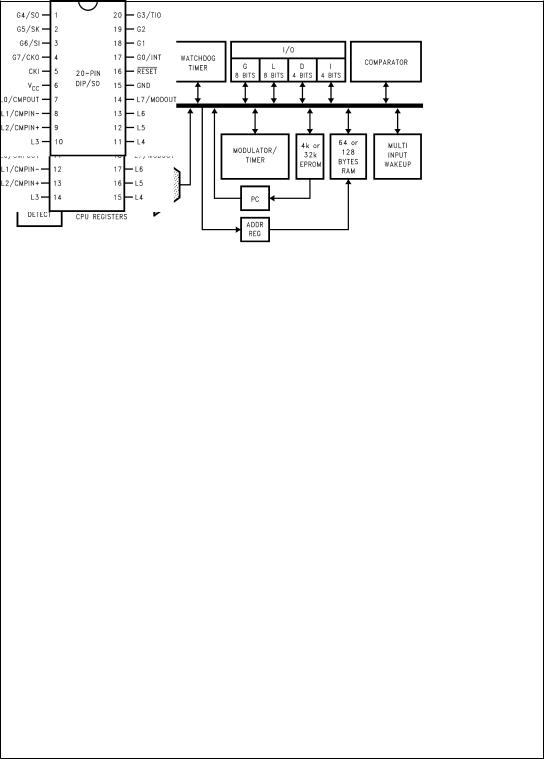
Block Diagram
DS012529-1
FIGURE 1. Block Diagram
Connection Diagrams
DS012529-2
Top View
Order Number COP87L20CJN (-1N, -2N, -3N), or COP87L20CJM(-1N, -2N, -3N), or COP87L40CJN (-1N, -2N, -3N), or COP87L40CJM (-1N, -2N, -3N), or COP87L40RJN (-1N, -2N, -3N), or
COP87L40RJM (-1N, -2N, -3N)
See NS Package Number N28B or M28B
DS012529-3
Top View
Order Number COP87L22CJN (-1N, -2N, -3N), or COP87L22CJM(-1N, -2N, -3N), or COP87L42CJN (-1N, -2N, -3N), or COP87L42CJM (-1N, -2N, -3N), or COP87L42RJN (-1N, -2N, -3N), or
COP87L42RJM (-1N, -2N, -3N)
See NS Package Number N20A or M20B
FIGURE 2. Connection Diagrams
Note: -1 Crystal Oscillator |
N - Brown out disabled |
-2 External Oscillator
-3 R/C Oscillator
www.national.com |
2 |

Pin Assignment
|
Port |
Typ |
ALT |
20 |
28 |
|
|
Pin |
Funct. |
Pin |
Pin |
||
|
|
|||||
|
|
|
|
|
|
|
|
L0 |
I/O |
MIWU/CMPOUT |
7 |
11 |
|
|
|
|
|
|
|
|
|
L1 |
I/O |
MIWU/CMPIN− |
8 |
12 |
|
|
|
|
|
|
|
|
|
L2 |
I/O |
MIWU/CMPIN+ |
9 |
13 |
|
|
|
|
|
|
|
|
|
L3 |
I/O |
MIWU |
10 |
14 |
|
|
|
|
|
|
|
|
|
L4 |
I/O |
MIWU |
11 |
15 |
|
|
|
|
|
|
|
|
|
L5 |
I/O |
MIWU |
12 |
16 |
|
|
|
|
|
|
|
|
|
L6 |
I/O |
MIWU |
13 |
17 |
|
|
|
|
|
|
|
|
|
L7 |
I/O |
MIWU/MODOUT |
14 |
18 |
|
|
|
|
|
|
|
|
|
G0 |
I/O |
INTR |
17 |
25 |
|
|
|
|
|
|
|
|
|
G1 |
I/O |
|
18 |
26 |
|
|
|
|
|
|
|
|
|
G2 |
I/O |
|
19 |
27 |
|
|
G3 |
I/O |
TIO |
20 |
28 |
|
|
|
|
|
|
|
|
|
G4 |
I/O |
SO |
1 |
1 |
|
|
|
|
|
|
|
|
|
G5 |
I/O |
SK |
2 |
2 |
|
|
|
|
|
|
|
|
|
G6 |
I |
SI |
3 |
3 |
|
|
G7 |
I |
CKO |
4 |
4 |
|
|
|
|
|
|
|
|
|
I0 |
I |
|
|
7 |
|
|
|
|
|
|
|
|
|
I1 |
I |
|
|
8 |
|
|
|
|
|
|
|
|
|
I2 |
I |
|
|
9 |
|
|
|
|
|
|
|
|
|
I3 |
I |
|
|
10 |
|
|
|
|
|
|
|
|
|
D0 |
O |
|
|
19 |
|
|
|
|
|
|
|
|
|
D1 |
O |
|
|
20 |
|
|
|
|
|
|
|
|
|
D2 |
O |
|
|
21 |
|
|
|
|
|
|
|
|
|
D3 |
O |
|
|
22 |
|
|
|
|
|
|
|
|
|
VCC |
|
|
6 |
6 |
|
GND |
|
|
15 |
23 |
||
|
|
|
|
|
|
|
CKI |
|
|
5 |
5 |
||
|
|
|
|
|
|
|
|
|
|
16 |
24 |
||
|
RESET |
|
|
|
||
3 |
www.national.com |

Absolute Maximum Ratings (Note 1)
If Military/Aerospace specified devices are required, please contact the National Semiconductor Sales Office/ Distributors for availability and specifications.
Supply Voltage (VCC) |
7.0V |
Voltage at any Pin |
−0.3V to V CC + 0.3V |
Total Current into VCC pin (Source) |
80 mA |
Total Current out of GND pin (sink) |
80 mA |
Storage Temperature Range |
−65ÊC to +150ÊC |
Note 1: Absolute maximum ratings indicate limits beyond which damage to the device may occur. DC and AC electrical specifications are not ensured when operating the device at absolute maximum ratings.
DC Electrical Characteristics
−40ÊC ≤ TA ≤ +85ÊC unless otherwise specified
Parameter |
Conditions |
Min |
Typ |
Max |
Units |
|
|
|
|
|
|
Operating Voltage |
|
2.7 |
|
5.5 |
V |
Power Supply Ripple 1 (Note 2) |
Peak to Peak |
|
|
0.1 VCC |
V |
Supply Current (Note 3) |
|
|
|
|
|
CKI = 10 MHz |
VCC = 5.5V, tc = 1 µs |
|
|
12 |
mA |
CKI = 4 MHz |
VCC = 4.5V, tc = 2.5 µs |
|
|
6.5 |
mA |
CKI = 4 MHz (COP87L20CJ) |
VCC = 4.0V, tc = 2.5 µs |
|
|
10 |
mA |
HALT Current (Note 4) |
VCC = 5.5V, CKI = 0 MHz |
|
|
12 |
µA |
INPUT LEVELS (VIH, VIL) |
|
|
|
|
|
Reset, CKI: |
|
|
|
|
|
Logic High |
|
0.8 VCC |
|
|
V |
Logic Low |
|
|
|
0.2 VCC |
V |
All Other Inputs |
|
|
|
|
|
Logic High |
|
0.7 VCC |
|
|
V |
Logic Low |
|
|
|
0.2 VCC |
V |
Hi-Z Input Leakage |
VCC = 5.5V |
−2 |
|
+2 |
µA |
Input Pullup Current |
VCC = 5.5V |
−40 |
|
−250 |
µA |
L- and G-Port Hysteresis (Note 7) |
|
|
|
0.35 VCC |
V |
Output Current Levels |
|
|
|
|
|
D Outputs: |
|
|
|
|
|
Source |
VCC = 4.5V, VOH = 3.8V |
−0.4 |
|
|
mA |
Sink (Note 5) |
VCC = 4.5V, VOL = 1.0V |
10 |
|
|
mA |
L4±L7 Output Sink |
VCC = 4.5V, VOL = 2.5V |
15 |
|
|
mA |
All Others |
|
|
|
|
|
Source (Weak Pull-up Mode) |
VCC = 4.5V, VOH = 3.2V |
−10 |
|
−110 |
µA |
Source (Push-pull Mode) |
VCC = 4.5V, VOH = 3.8V |
−0.4 |
|
|
mA |
Sink (Push-pull Mode) |
VCC = 4.5V, VOL = 0.4V |
1.6 |
|
|
mA |
(COP887L20CJ) |
VCC = 5.5V, VOL = 0.4V |
|
|
|
|
TRI-STATE Leakage |
|
−2.0 |
|
+2.0 |
µA |
|
|
|
|
|
|
Allowable Sink/Source |
|
|
|
|
|
Current Per Pin |
|
|
|
|
|
D Outputs |
|
|
|
15 |
mA |
L4±L7 (Sink) |
|
|
|
20 |
mA |
All Others |
|
|
|
3 |
mA |
|
|
|
|
|
|
Maximum Input Current |
Room Temperature |
|
|
±100 |
mA |
without Latchup (Note 6) |
|
|
|
|
|
|
|
|
|
|
|
RAM Retention Voltage, Vr |
500 ns Rise and |
2.0 |
|
|
V |
|
Fall Time (Min) |
|
|
|
|
|
|
|
|
|
|
Input Capacitance |
|
|
|
7 |
pF |
|
|
|
|
|
|
Load Capacitance on D2 |
|
|
|
1000 |
pF |
|
|
|
|
|
|
Note 2: Rate of voltage change must be less than 10 V/mS.
Note 3: Supply current is measured after running 2000 cycles with a square wave CKI input, CKO open, inputs at rails and outputs open.
www.national.com |
4 |
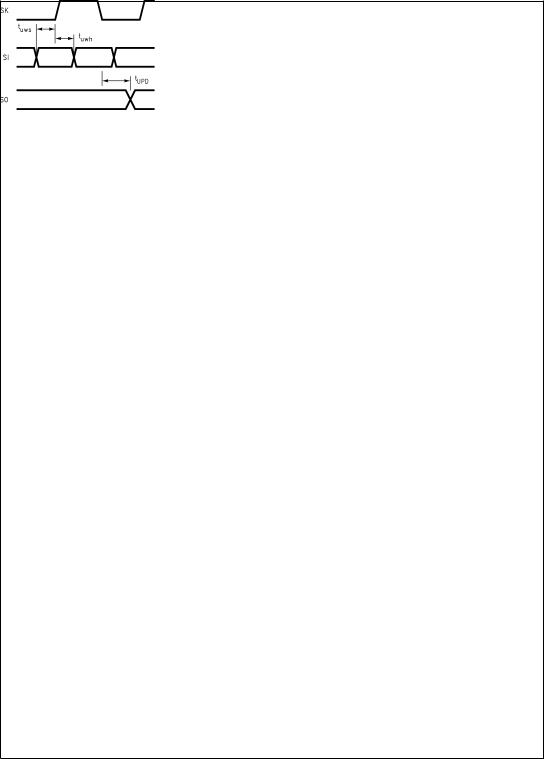
DC Electrical Characteristics (Continued)
Note 4: The HALT mode will stop CKI from oscillating in the RC and crystal configurations by bringing CKI high. HALT test conditions: L, and G0..G5 ports configured as outputs and set high. The D port set to zero. All inputs tied to VCC. The comparator is disabled.
Note 5: The user must guarantee that D2 pin does not source more than 10 mA during RESET. If D2 sources more than 10 mA during reset, the device will go into programming mode.
Note 6: Pins G6 and RESET are designed with a high voltage input network. These pins allow input voltages greater than VCC and the pins will have sink current to VCC when biased at voltages greater than VCC (the pins do not have source current when biased at a voltage below VCC). The effective resistance to VCC is 750Ω (typical). These two pins will not latch up. The voltage at the pins must be limited to less than 14V.
AC Electrical Characteristics
−40ÊC ≤ TA ≤ +85ÊC unless otherwise specified
Parameter |
Conditions |
Min |
Typ |
Max |
Units |
|
|
|
|
|
|
Instruction Cycle Time (tc) |
|
|
|
|
|
Crystal/Resonator |
4.5V ≤ VCC ≤ 5.5V |
1 |
|
DC |
µs |
R/C Oscillator |
4.5V ≤ VCC ≤ 5.5V |
2 |
|
DC |
µs |
CKI Clock Duty Cycle (Note 7) |
fr = Max |
40 |
|
60 |
% |
Rise Time (Note 7) |
fr = 10 MHz ext. Clock |
|
|
12 |
ns |
Fall Time (Note 7) |
fr = 10 MHz ext. Clock |
|
|
8 |
ns |
|
|
|
|
|
|
Inputs |
|
|
|
|
|
tSetup |
4.5V ≤ VCC ≤ 5.5V |
200 |
|
|
ns |
tHold |
4.5V ≤ VCC ≤ 5.5V |
60 |
|
|
ns |
Output Propagation Delay |
RL = 2.2k, CL = 100 pF |
|
|
|
|
tPD1, tPD0 |
|
|
|
|
|
SO, SK |
4.5V ≤ VCC ≤ 5.5V |
|
|
0.7 |
µs |
All Others |
4.5V ≤ VCC ≤ 5.5V |
|
|
1 |
µs |
Input Pulse Width |
|
|
|
|
|
Interrupt Input High Time |
|
1 |
|
|
tc |
Interrupt Input Low Time |
|
1 |
|
|
tc |
Timer Input High Time |
|
1 |
|
|
tc |
Timer Input Low Time |
|
1 |
|
|
tc |
|
|
|
|
|
|
MICROWIRE™ Setup Time (tµWS) |
|
20 |
|
|
ns |
MICROWIRE Hold Time (tµWH) |
|
56 |
|
|
ns |
MICROWIRE Output |
|
|
|
220 |
ns |
Propagation Delay (tµPD) |
|
|
|
|
|
Reset Pulse Width |
|
1 |
|
|
µs |
|
|
|
|
|
|
Note 7: Parameter characterized but not production tested.
DS012529-4
FIGURE 3. MICROWIRE/PLUS Timing
5 |
www.national.com |

Pin Description
VCC and GND are the power supply pins.
CKI is the clock input. This can come from an external source, a R/C generated oscillator or a crystal (in conjunction with CKO). See Oscillator description.
RESET is the master reset input. See Reset description.
PORT I is a 4-bit Hi-Z input port.
PORT L is an 8-bit I/O port.
There are two registers associated with the L port: a data register and a configuration register. Therefore, each L I/O bit can be individually configured under software control as shown below:
Port L |
Port L |
Port L |
Config. |
Data |
Setup |
0 |
0 |
Hi-Z Input (TRI-STATE) |
0 |
1 |
Input with Weak Pull-up |
1 |
0 |
Push-pull Zero Output |
1 |
1 |
Push-pull One Output |
|
|
|
Three data memory address locations are allocated for this port, one each for data register [00D0], configuration register [00D1] and the input pins [00D2].
Port L has the following alternate features:
L7 MIWU or MODOUT (high sink current capability)
L6 MIWU (high sink current capability)
L5 MIWU (high sink current capability)
L4 MIWU (high sink current capability)
L3 MIWU
L2 MIWU or CMPIN+
L1 MIWU or CMPIN−
L0 MIWU or CMPOUT
The selection of alternate Port L functions is done through registers WKEN [00C9] to enable MIWU and CNTRL2 [00CC] to enable comparator and modulator.
All eight L-pins have Schmitt Triggers on their inputs.
PORT G is an 8-bit port with 6 I/O pins (G0±G5) and 2 input pins (G6, G7).
All eight G-pins have Schmitt Triggers on the inputs.
There are two registers associated with the G port: a data register and a configuration register. Therefore each G port bit can be individually configured under software control as shown below:
Port G |
Port G |
Port G |
Config. |
Data |
Setup |
0 |
0 |
Hi-Z Input (TRI-STATE) |
0 |
1 |
Input with Weak Pull-up |
1 |
0 |
Push-pull Zero Output |
1 |
1 |
Push-pull One Output |
Three data memory address locations are allocated for this port, one for data register [00D4], one for configuration register [00D5] and one for the input pins [00D6]. Since G6 and G7 are Hi-Z input only pins, any attempt by the user to configure them as outputs by writing a one to the configuration register will be disregarded. Reading the G6 and G7 configuration bits will return zeros. Note that the device will be placed in the Halt mode by writing a ª1º to the G7 data bit.
Six pins of Port G have alternate features:
G7 CKO crystal oscillator output (selected by mask option) or HALT restart input/general purpose input (if clock option is R/C or external clock)
G6 SI (MICROWIRE serial data input)
G5 SK (MICROWIRE clock I/O)
G4 SO (MICROWIRE serial data output)
G3 TIO (timer/counter input/output)
G0 INTR (an external interrupt)
Pins G2 and G1 currently do not have any alternate functions.
The selection of alternate Port G functions are done through registers PSW [00EF] to enable external interrupt and CNTRL1 [00EE] to select TIO and MICROWIRE operations.
PORT D is a four bit output port that is preset when RESET goes low. One data memory address location is allocated for the data register [00DC]. The user can tie two or more D port outputs (except D2 pin) together in order to get a higher drive.
Note: Care must be exercised with the D2 pin operation. At RESET, the external loads on this pin must ensure that the output voltages stay above 0.8 VCC to prevent the chip from entering special modes. Also keep the external loading on D2 to less than 1000 pF.
Functional Description
The internal architecture is shown in the block diagram. Data paths are illustrated in simplified form to depict how the various logic elements communicate with each other in implementing the instruction set of the device.
ALU and CPU Registers
The ALU can do an 8-bit addition, subtraction, logical or shift operations in one cycle time. There are five CPU registers:
A is the 8-bit Accumulator register
PC is the 15-bit Program Counter register
PU is the upper 7 bits of the program counter (PC)
PL is the lower 8 bits of the program counter (PC)
Bis the 8-bit address register and can be auto incremented or decremented.
Xis the 8-bit alternate address register and can be auto incremented or decremented.
SP is the 8-bit stack pointer which points to the subroutine stack (in RAM).
B, X and SP registers are mapped into the on chip RAM. The B and X registers are used to address the on chip RAM. The SP register is used to address the stack in RAM during subroutine calls and returns. The SP must be initialized by software before any subroutine call or interrupts occurs.
Memory
The memory is separated into two memory spaces: program and data.
PROGRAM MEMORY
Program memory consists of 4 kbytes of OTP EPROM. These bytes of ROM may be instructions or constant data. The memory is addressed by the 15-bit program counter (PC). ROM can be indirectly read by the LAID instruction for table lookup.
The device can be configured to inhibit external reads of the program memory. This is done by programming the Security Byte.
www.national.com |
6 |
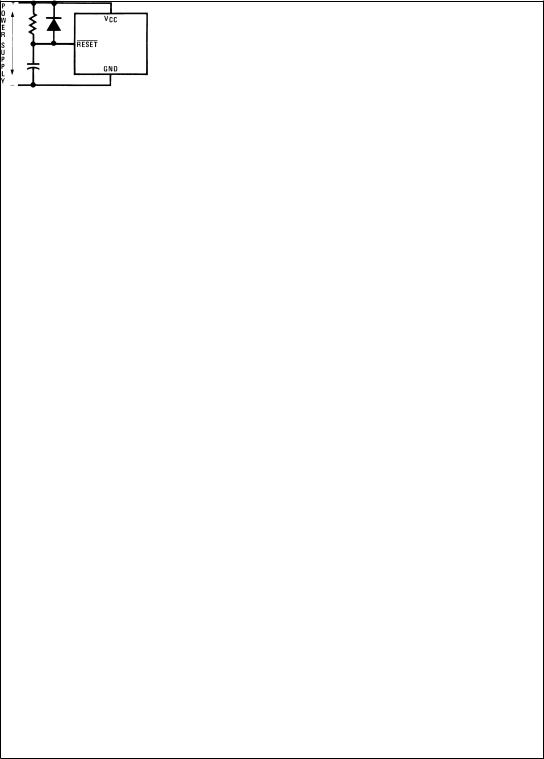
Memory (Continued)
SECURITY FEATURE
The memory array has an associate Security Byte that is located outside of the program address range. This byte can be addressed only from programming mode by a programmer tool.
Security is an optional feature and can only be asserted after the memory arrary has been programmed and verified. A secured part will read all 00(hex) by a programmer. The part will fail Blank Check and will fail Verify operations. A Read operation will fill the programmer's memory with 00(hex). The Security Byte itself is always readable with value of 00(hex) if unsecure and FF(hex) if secure.
DATA MEMORY
The data memory address space includes on chip RAM, I/O and registers. Data memory is addressed directly by the instruction or indirectly through B, X and SP registers. The device has 128 bytes of RAM. Sixteen bytes of RAM are mapped as ªregistersº, these can be loaded immediately, decremented and tested. Three specific registers: X, B, and SP are mapped into this space, the other registers are available for general usage.
Any bit of data memory can be directly set, reset or tested. All I/O and registers (except A and PC) are memory mapped; therefore, I/O bits and register bits can be directly and individually set, reset and tested, except the write once only bit (WDREN, WATCHDOG Reset Enable), and the unused and read only bits in CNTRL2 and WDREG registers.
Note: RAM contents are undefined upon power-up.
Reset
EXTERNAL RESET
The RESET input pin when pulled low initializes the micro-controller. The user must insure that the RESET pin is held low until VCC is within the specified voltage range and the clock is stabilized. An R/C circuit with a delay 5x greater than the power supply rise time is recommended (Figure 4). The device immediately goes into reset state when the RESET input goes low. When the RESET pin goes high the device comes out of reset state synchronously. The device will be running within two instruction cycles of the RESET pin going high. The following actions occur upon reset:
Port L |
TRI-STATE |
|
|
Port G |
TRI-STATE |
|
|
Port D |
HIGH |
|
|
PC |
CLEARED |
|
|
RAM Contents |
RANDOM with Power-On- |
|
Reset |
|
UNAFFECTED with external |
|
Reset (power already |
|
applied) |
|
|
B, X, SP |
Same as RAM |
|
|
PSW, CNTRL1, CNTRL2 |
|
and WDREG Reg. |
CLEARED |
|
|
Multi-Input Wakeup Reg. |
|
WKEDG, WKEN |
CLEARED |
WKPND |
UNKNOWN |
Data and Configuration |
|
Registers for L & G |
CLEARED |
|
|
WATCHDOG Timer |
Prescaler/Counter each |
|
loaded with FF |
|
|
The device comes out of the HALT mode when the RESET pin is pulled low. In this case, the user has to ensure that the RESET signal is low long enough to allow the oscillator to restart. An internal 256 tc delay is normally used in conjunction with the two pin crystal oscillator. When the device comes out of the HALT mode through Multi-Input Wakeup, this delay allows the oscillator to stabilize.
The following additional actions occur after the device comes out of the HALT mode through the RESET pin.
If a two pin crystal/resonator oscillator is being used:
RAM Contents |
UNCHANGED |
|
|
Timer T1 and A Contents |
UNKNOWN |
|
|
WATCHDOG Timer Prescaler/Counter |
ALTERED |
|
|
If the external or RC Clock option is being used: |
|
|
|
RAM Contents |
UNCHANGED |
|
|
Timer T1 and A Contents |
UNCHANGED |
|
|
WATCHDOG Timer Prescaler/Counter |
ALTERED |
|
|
DS012529-5
RC > 5 x Power Supply Rise Time
FIGURE 4. Recommended Reset Circuit
WATCHDOG RESET
With WATCHDOG enabled, the WATCHDOG logic resets the device if the user program does not service the WATCHDOG timer within the selected service window. The WATCHDOG reset does not disable the WATCHDOG. Upon WATCHDOG reset, the WATCHDOG Prescaler/Counter are each initialized with FF Hex.
The following actions occur upon WATCHDOG reset that are different from external reset.
WDREN |
WATCHDOG Reset Enable bit |
UNCHANGED |
WDUDF |
WATCHDOG Underflow bit |
UNCHANGED |
Additional initialization actions that occur as a result of WATCHDOG reset are as follows:
Port L |
TRI-STATE |
|
|
Port G |
TRI-STATE |
|
|
Port D |
HIGH |
|
|
PC |
CLEARED |
|
|
Ram Contents |
UNCHANGED |
|
|
B, X, SP |
UNCHANGED |
|
|
PSW, CNTRL1 and CNTRL2 |
|
(except |
|
WDUDF Bit) Registers |
CLEARED |
|
|
7 |
www.national.com |
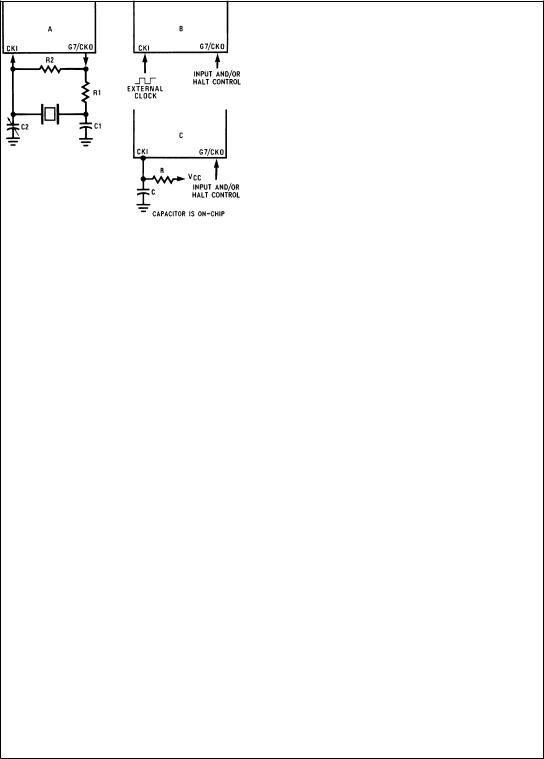
Reset (Continued)
Multi-Input Wakeup Registers |
|
WKEDG, WKEN |
CLEARED |
WKPND |
UNKNOWN |
|
|
Data and Configuration |
|
Registers for L & G |
CLEARED |
|
|
WATCHDOG Timer |
Prescalar/Counter |
|
each loaded with FF |
Oscillator Circuits |
|
EXTERNAL OSCILLATOR
By selecting the external oscillator option, the CKI pin can be driven by an external clock signal provided it meets the specified duty cycle, rise and fall times, and input levels. The G7/CKO is available as a general purpose input G7 and/or HALT control.
CRYSTAL OSCILLATOR
By selecting the crystal oscillator option, the G7/CKO pin is connected as a clock output, CKI and G7/CKO can be connected to make a crystal controlled oscillator. Table 1 shows the clock frequency for different component values. See Figure 5 for the connections.
R/C OSCILLATOR
By selecting R/C oscillator option, connecting a resistor from the CKI pin to VCC makes a R/C oscillator. The capacitor is on-chip. The G7/CKO pin is available as a general purpose input G7 and/or HALT control. Adding an external capacitor will jeopardize the clock frequency tolerance and increase EMI emissions.
Table 2 shows the clock frequency for the different resistor values. The capacitor is on-chip. See Figure 5 for the connections.
|
|
|
|
|
|
DS012529-6 |
|
|
|
FIGURE 5. Clock Oscillator Configurations |
|
|
|||
|
|
TABLE 1. Crystal Oscillator Configuration |
|
|
|||
|
|
|
|
|
|
|
|
R1 |
R2 |
|
C1 |
C2 |
CKI Freq. |
|
Conditions |
(kΩ) |
(MΩ) |
|
(pF) |
(pF) |
(MHz) |
|
|
|
|
|
|
|
|
|
|
0 |
1 |
|
30 |
30±36 |
10 |
|
VCC = 5V |
0 |
1 |
|
30 |
30±36 |
4 |
|
VCC = 5V |
5.6 |
1 |
|
100 |
100±156 |
0.455 |
|
VCC = 5V |
TABLE 2. RC Oscillator Configuration (Part-To-Part Variation) TA = 25ÊC
R |
CK1 Freq. |
Instr. Cycle |
Conditions |
(kΩ) |
(MHz) |
(µs) |
|
|
|
|
|
8.2 |
3.3 ±10% |
3.0 ±10% |
VCC = 5V |
2.2 |
1.3 ±10% |
7.7 ±10% |
VCC = 5V |
3.9 |
0.75 ±10% |
13.3 ±10% |
VCC = 5V |
www.national.com |
8 |
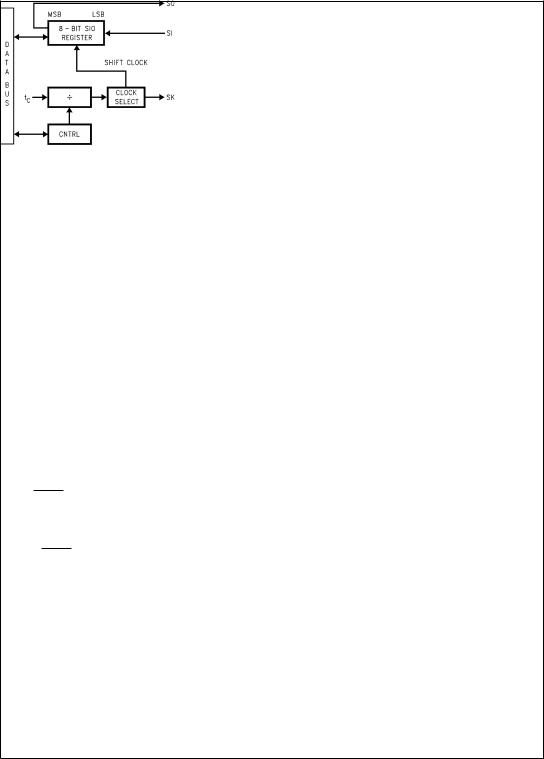
Halt Mode
The device is a fully static device. The device enters the HALT mode by writing a one to the G7 bit of the G data register. Once in the HALT mode, the internal circuitry does not receive any clock signal and is therefore frozen in the exact state it was in when halted. In this mode the chip will only draw leakage current.
The device supports three different methods of exiting the HALT mode. The first method is with a low to high transition on the CKO (G7) pin. This method precludes the use of the crystal clock configuration (since CKO is a dedicated output). It may be used either with an RC clock configuration or an external clock configuration. The second method of exiting the HALT mode is with the multi-Input Wakeup feature on the L port. The third method of exiting the HALT mode is by pulling the RESET input low.
If the two pin crystal/resonator oscillator is being used and Multi-Input Wakeup causes the device to exit the HALT mode, the WAKEUP signal does not allow the chip to start running immediately since crystal oscillators have a delayed start up time to reach full amplitude and freuqency stability. The WATCHDOG timer (consisting of an 8-bit prescaler followed by an 8-bit counter) is used to generate a fixed delay of 256tc to ensure that the oscillator has indeed stabilized before allowing instruction execution. In this case, upon detecting a valid WAKEUP signal only the oscillator circuitry is enabled. The WATCHDOG Counter and Prescaler are each loaded with a value of FF Hex. The WATCHDOG prescaler is clocked with the tc instruction cycle. (The tc clock is derived by dividing the oscillator clock down by a factor of 10).
The Schmitt trigger following the CKI inverter on the chip ensures that the WATCHDOG timer is clocked only when the oscillator has a sufficiently large amplitude to meet the Schmitt trigger specs. This Schmitt trigger is not part of the oscillator closed loop. The start-up timeout from the WATCHDOG timer enables the clock signals to be routed to the rest of the chip. The delay is not activated when the device comes out of HALT mode through RESET pin. Also, if the clock option is either RC or External clock, the delay is not used, but the WATCHDOG Prescaler/-Counter contents are changed. The Development System will not emulate the 256tc delay.
The RESET pin will cause the device to reset and start executing from address X'0000. A low to high transition on the G7 pin (if single pin oscillator is used) or Multi-Input Wakeup will cause the device to start executing from the address following the HALT instruction.
When RESET pin is used to exit the device from the HALT mode and the two pin crystal/resonator (CKI/CKO) clock option is selected, the contents of the Accumulator and the Timer T1 are undetermined following the reset. All other information except the WATCHDOG Prescaler/Counter contents is retained until continuing. All information except the WATCHDOG Prescaler/Counter contents is retained if the device exits the HALT mode through G7 pin or Multi-Input Wakeup.
G7 is the HALT-restart pin, but it can still be used as an input. If the device is not halted, G7 can be used as a general purpose input.
Note: To allow clock resynchronization, it is necessary to program two NOP's immediately after the device comes out of the HALT mode. The user must program two NOP's following the ªenter HALT modeº (set G7 data bit) instruction.
MICROWIRE/PLUS
MICROWIRE/PLUS is a serial synchronous bidirectional communications interface. The MICROWIRE/PLUS capability enables the device to interface with any of National Semiconductor's MICROWIRE peripherals (i.e. A/D converters, display drivers, EEPROMS, etc.) and with other microcontrollers which support the MICROWIRE/PLUS interface. It consists of an 8-bit serial shift register (SIO) with serial data input (SI), serial data output (SO) and serial shift clock (SK). Figure 6 shows the block diagram of the MICROWIRE/PLUS interface.
DS012529-7
FIGURE 6. MICROWIRE/PLUS Block Diagram
The shift clock can be selected from either an internal source or an external source. Operating the MICROWIRE/PLUS interface with the internal clock source is called the Master mode of operation. Operating the MICROWIRE/PLUS interface with an external shift clock is called the Slave mode of operation.
The CNTRL register is used to configure and control the MICROWIRE/PLUS mode. To use the MICROWIRE/PLUS , the MSEL bit in the CNTRL register is set to one. The SK clock rate is selected by the two bits, SL0 and SL1, in the CNTRL register. Table 3 details the different clock rates that may be selected.
TABLE 3.
SL1 |
SL0 |
SK Cycle Time |
|
|
|
0 |
0 |
2tc |
0 |
1 |
4tc |
1 |
x |
8tc |
where,
tc is the instruction cycle time.
MICROWIRE/PLUS OPERATION
Setting the BUSY bit in the PSW register causes the MICROWIRE/PLUS arrangement to start shifting the data. It gets reset when eight data bits have been shifted. The user may reset the BUSY bit by software to allow less than 8 bits to shift. The device may enter the MICROWIRE/PLUS mode either as a Master or as a Slave. Figure 7 shows how two device microcontrollers and several peripherals may be interconnected using the MICROWIRE/PLUS arrangement.
Master MICROWIRE/PLUS Operation
In the MICROWIRE/PLUS Master mode of operation the shift clock (SK) is generated internally by the device. The MICROWIRE/PLUS Master always initiates all data ex-
9 |
www.national.com |
